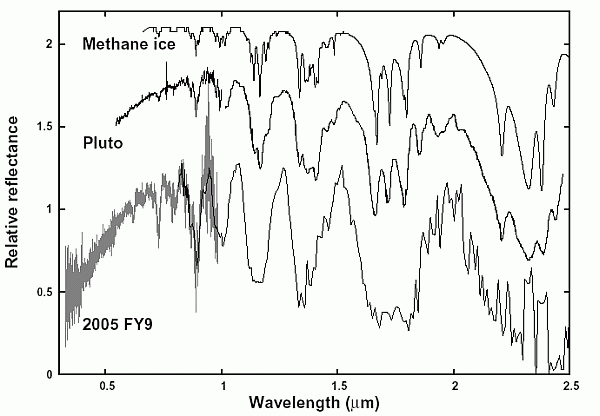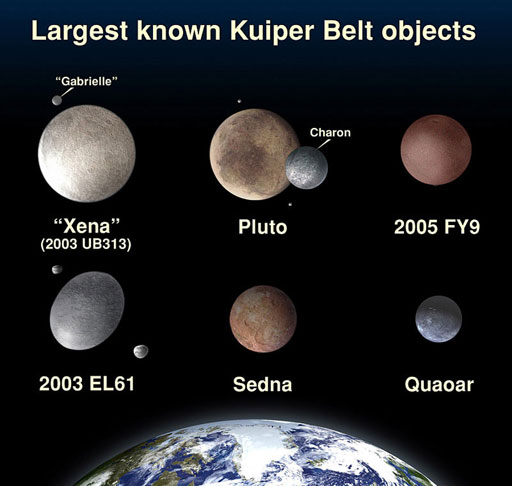|
Enigmas in Our Solar System New Planets Discovered |
|
|
.
The image below and to the left is a CCD image of the recently announced Kuiper Belt Object (KBO) 2005 FY9 taken on September 3rd at Fremont Peak State Park in Northern California. The image consists of four 30 second exposures that have been stacked using the AIP4WIN software. A Meade LX200 F/6.3 SCT coupled with an SBIG ST-9XE camera were used to take the shots. 2005 FY9 is indicated with the red arrow. The circle is where the software says the object ought to have been at the time the image was taken. The green circles and text simply indicate which stars I used as reference in determining the exact location of the target object. In addition, comparison with an online image (shown on the right) shows no object at that point, even though it registers stars fainter than my image. 2005 FY9 is roughly magnitude 17.0, but these shots were taken when the object was low in the sky, so there is substantial attenuation due to the atmosphere. The online image is rotated roughly 60 degrees CCW relative to the left image; I have added two of the reference points in green to help orient the two. In case you're wondering, I took
four 30 second exposures rather than one 2 minute
exposure because my telescope
was mounted on an alt-azmith mount. This means
that I get field rotation
for even relatively short exposure times, and more
important I can't engage
the periodic error correction mode on the scope
drive (the later models
supposedly do have this feature available in
alt-az mode). I also haven't
been able to get the ST9-XE to self guide - and I
haven't had time to play
with it yet.
SOURCE: http://www.biathlon.net/Astrophotography/FY9_index.html |
|
Graph
|
|
TNG and WHT Observations Prove that the Large Trans-Neptunian Object 2005 FY9 is Very Similar to PlutoVisible and
near-infrared spectroscopic observations carried
out on August 1st 2005 by a group led by the ING-IAC
astronomer Javier
Licandro1
using the Telescopio
Nazionale Galileo
(TNG) and the William
Herschel Telescope (WHT) simultaneously show
that the recently discovered
trans-neptunian object (TNO) 2005 FY9 is
very similar to Pluto.
Results have been published in the journal Astronomy
& Astrophysics
(Licandro
et al., 2006, A&A, 445, 35L).
2005 FY9 is the third brightest known TNO, after 2003 UB313 and Pluto. Although discovered early in 2005 by USA astronomers M. Brown and co-workers, the discovery wasn't reported until July 29th. The size of 2005 FY9 is 0.7 times that of Pluto approximately. The semi-major axis of its orbit is 46 Astronomical Units (AU, 1 AU=149,597,892 kilometres), the perihelion distance is 39 AU and the inclination of the orbit is 29°. These values are typical of the classical TNO family. Near-infrared spectroscopy was obtained using the NICS spectrograph on the TNG and visible spectroscopy was obtained using the ISIS spectrograph on the WHT. The complete visible and near-infrared spectrum is shown in Figure 2 and compared with the spectrum of Pluto and that of pure methane ice. Figure 2 clearly shows that the spectra of both TNOs are very similar. They are dominated by strong absorption bands produced by methan ice. In fact, the absorption bands in the spectrum of 2005 FY9 are deeper than in the spectrum of Pluto as a result of the larger abundance of methane ice in 2005 FY9. Also the colour of the surface of the TNO is red (indicated by the slope of the spectrum), similar to that of Pluto. This shows the presence of complex organic compounds in the surface. 
Figure 2. The spectrum of 2005 FY9 compared with the spectrum of Pluto and that of pure methane ice. Notice the strong methane ice absorption bands present in the spectrum of both TNOs. The discovery of a Pluto 'twin' in the trans-neptunian belt is relevant as Pluto is the only known TNO possessing a small atmosphere. The similar size and surface composition of 2005 FY9 are facts that suggest it can also have such a tenuous bound atmosphere. Until now only one known TNO, Pluto, showed the presence of strong methan ice absorption bands in the spectrum. However, apart from 2005 FY9, recently these bands were also observed in the spectrum of the largest yet known TNO, 2003 UB313 (Brown et al., 2005, ApJ, 635, 97). As shown in Figure 3, the near infrared spectrum of 2003 UB313 is very similar to that of 2005 FY9. 
Figure 3. Near infrared spectrum of 2005 FY9 obtained by Licandro et al. (2006) compared with that of TNO 2003 UB313 from Brown et al. (2005) . The similarity of both spectra shows that the surface composition of both objects must be also similar. The discovery that 2005 FY9 is very similar to Pluto provides astronomers with a new and exciting laboratory for the study of volatile mixing and transport, atmospheric freeze-out and escape, ice chemistry, and nitrogen phase transitions in Pluto-like objects. Notes: |
|
|
.
OTHERS |
|
| FAIR USE NOTICE: This page contains copyrighted material the use of which has not been specifically authorized by the copyright owner. Pegasus Research Consortium distributes this material without profit to those who have expressed a prior interest in receiving the included information for research and educational purposes. We believe this constitutes a fair use of any such copyrighted material as provided for in 17 U.S.C § 107. If you wish to use copyrighted material from this site for purposes of your own that go beyond fair use, you must obtain permission from the copyright owner. | |
|
|



